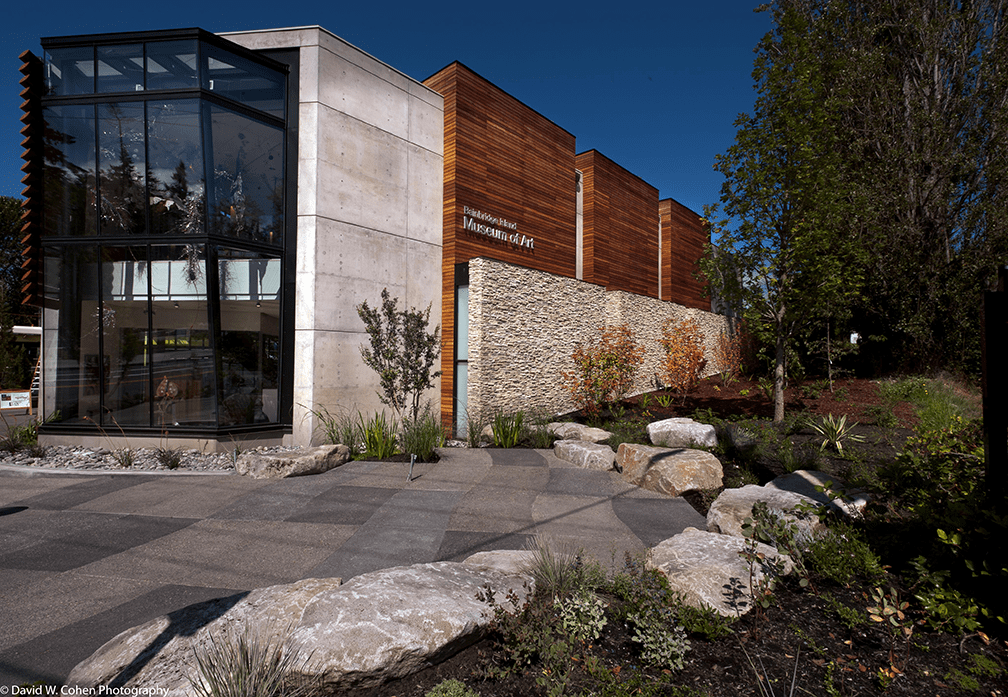Bainbridge Island Museum of Art near Seattle has earned the vaunted LEED Gold environmental certification, making it the first new art museum in Washington state to achieve the Gold rating.
The certification is thanks to a newly expanded solar array using APsystems YC500 dual-module microinverters.
This past fall the museum nearly doubled its array to 100 modules. The 28kW system caps a host of advanced sustainability features that extend from the roof down into the earth beneath the museum itself.

“What’s thrilling about this achievement is that it affirms how deeply Bainbridge Island and the museum itself care about all aspects of community vitality and wellbeing,” said Sheila Hughes, BIMA Executive Director. “We live, work, visit and raise families in a place that invests equally and deeply in cultural enrichment and in sustainability.
“It’s wonderful to see BIMA’s LEED Gold status, made possible through the generosity of its local donors, as a leading example of both.”
The U.S. Green Building Council’s LEED certification – for Leadership in Energy and Environmental Design – is a progressive code that rates new buildings for sustainability and promotes eco-friendly construction techniques.
Designed by Bainbridge architect Matthew Coates, of Coates Design Architects, BIMA earned high marks for innovation in design, indoor environmental quality, water efficiency, and site sustainability.
“Art museums are inherently energy-intensive, making LEED Gold designation an extremely challenging goal,” Coates said. “We’re proud to demonstrate that architects, builders and clients can work together to create beautiful buildings for our environment and for our planet.”
General contractor PHC Construction worked with the museum staff to secure LEED Gold certification. The expanded PV array provided the final “points” required under the LEED scoring system.
The array uses APsystems YC500 microinverters provided by Blue Frog Solar, and iTek Energy 240W and 280W modules.

The inverters were provided free of charge by Blue Frog Solar, Northwest distributor for APsytems USA.
“When the art museum came to us with their solar proposal a few years ago, we could tell it would be a special building in every way,” said Tim Bailey, Blue Frog Solar co-founder. “It’s been an honor to contribute to both phases of their solar project, and support such a great institution.”
Several other private donors stepped in so that the solar project had no effect on the non-profit art museum’s budget.
Installer was Puget Sound Solar of Seattle.
BIMA opened in June 2013 to showcase contemporary Northwest art and has been an unqualified success, recently welcoming its 250,000th visitor.
________________________
Building a sustainable museum
Architect Matthew Coates designed the museum to embody forward thinking in both aesthetics and sustainable materials and systems in a facility-scale building.
That commitment started below ground. A geo-exchange system uses 14 bores beneath the foundation to reduce the energy used for heating and cooling the building.

Drilled 400 feet, the bores act as a heat sink and source at a constant ground temperature of approximately 50 degrees. The system is designed to reduce heating and cooling energy by 90 percent, and to cut peak heating and cooling loads in half.
Thanks to the musuem’s sunny southern exposure, nearly all of the publicly occupied spaces enjoy generous natural light to further reduce energy usage for lighting.
A sophisticated louver system across the two-story glass façade tracks solar angles to reduce heat gain and glare inside.
Low-flow water fixtures inside and Northwest climate-appropriate landscaping reduce water demand.
During construction, 95 percent of construction waste was recycled, while more than 20 percent of new materials came from recycled sources. All paints, sealants and materials were selected to be non-toxic.
The site itself, on a prominent corner near the ferry terminal that connects the island with downtown Seattle, was reclaimed from a former automotive business.
During site preparation, numerous scrap automobiles and many hundreds of spent tires were excavated from the property and recycled.
BIMA now is an educational institution whose mission is “to engage a diverse population with the art and craft of our region and our time.”
The art museum exhibits, interprets, preserves, collects and promotes works of proven cultural value as well as new those by emerging artists and craftspeople.
Information: www.biartmuseum.org.
 Vegas, Here We Come!July 22, 2025 - 11:40 pm
Vegas, Here We Come!July 22, 2025 - 11:40 pm Meet Solar PupAugust 7, 2025 - 5:57 am
Meet Solar PupAugust 7, 2025 - 5:57 am APsystems Featured in Solar Builder: Leading the Charge on AI in SolarAugust 7, 2025 - 6:21 am
APsystems Featured in Solar Builder: Leading the Charge on AI in SolarAugust 7, 2025 - 6:21 am TEDDY Talks Takes Scottsdale: Two New Episodes Live!August 7, 2025 - 5:53 am
TEDDY Talks Takes Scottsdale: Two New Episodes Live!August 7, 2025 - 5:53 am Review APsystems & Win a $50 Starbucks Card!August 4, 2025 - 2:35 am
Review APsystems & Win a $50 Starbucks Card!August 4, 2025 - 2:35 am



Join APsystems for a connectivity webinar, March 29
/in Events, General News, Trainings, Webinar/by APsystems TeamToday’s solar customers have an almost bewildering array of choices (and acronyms) for linking the gateway to their router: Wi-Fi, EoP, TDMA, even old-school CAT-5 and CAT-6.
Which technology is right for your next installation? Find out through a new APsystems webinar, “Critical Connectivity: addressing site communication in a wireless (and sometimes wired) world,” to be offered 11:30 am EST March 29.
The webinar will be presented by Christopher Barrett, Director of Technical Services and Engineering for APsystems, and moderated by Kathie Zipp of Solar Power World.
Register for this informative session at www.solarpowerworldonline.com
APsystems to offer installer training, panel expertise at NABCEP 2017 in Dallas, March 21-23
/in Events, General News, Trainings/by APsystems TeamThe APsystems technical support team will offer installer training and panel expertise at NABCEP Continuing Education 2017, March 21-23 in Dallas.
Seminars include:
Microinverters in the Residential Environment – APsystems YC500 Dual Module Solution: Examine the advantage of microinverters in a single-phase residential application. Learn techniques of system designing for communication to minimize return site visits and maximize operation profits, demonstrated through the installation of the APsystems microinverters.
Commercial Three Phase Microinverter Solutions – Including Design for Communication: Understand the advantages of the Three-Phase microinverter in commercial markets. The seminar will emphasize the performance and versatility of the APsystems YC1000 three-phase microinverter, and designing systems for enhanced communication and monitoring freedom.
To register, email support@APsystems.com.
Presenters will be Christopher Barrett, Director of Engineering and Technical Services for APsystems, and John Doerr, APsystems applications engineer.
Christopher will also be a featured panelist at the NABCEP conference session “Improving System ROI through Best Practices in Solar PV Systems Design Installation, Monitoring and O & M,” is 3:30-5:30 pm Tuesday, March 21 in the Crystal Ballroom VIII.
Christopher brings more than 20 years’ experience in the solar and semiconductor industries. Prior to APsystems, he served as Technical Services Manager for SolarBridge Technologies, directing a multinational support center that monitored global PV installations, provided support and dispatched technicians to the field.
John Doerr contributes over 30 years of experience in management with startups, manufacturing and customer support, as well as national and international consulting. His work includes development and contractor management of commercial, residential and multifamily projects. John provides the pre- and post-sales technical training and supports installer needs for application engineering and design.
ABOUT NABCEP: The NABCEP CE conference is intended for professionals who need continuing education credits to maintain their NABCEP accreditation. The conference allows Certified PV Installation Professionals and PV Technical Sales Professionals to earn all of the credits needed for recertification (18 hours every three years), while non-certified professionals can earn up to 18 hours toward accreditation. Information: www.nabcep.org.
APsystems featured in Solar Builder Magazine’s special Inverter Issue
/in Article, General News, Press Coverage/by APsystems TeamSolar Builder Magazine’s special Inverter Issue is out now, and APsystems is featured throughout.
Always follow best practices to head off gateway communication issues, says Christopher Barrett, APsystems Director of Technical Services, in the “Ask An Expert” feature compiled by Solar Builder editors. Even in a “wireless” world, hard-wired CAT-5 connections can be the best and most reliable option, Christopher says – and save you the time and trouble of returning to the jobsite to sort out Wi-Fi problems.
Remember to compare warranties when doing your calculations – there’s real value in that certificate, should a system component ever need to be replaced. That’s one of the insights APsystems contributes to an informative story on Levelized Cost of Energy (LCOE), the formula that determines a solar array’s investment value over its lifetime.
Power and versatility are the hallmarks of the new APsystems YC500i with EnergyMax, a microinverter designed and built for today’s high-output modules, profiled in Solar Builder’s 2017 Inverter Buyers Guide.
Find out more about APsystems microinverters, “The Installers’ Choice,” on the inside front cover of the edition, on newsstands now.
Download the digital edition of Solar Builder’s Inverter Issue here.
Lighthouse & Bombard earn prestigious APsystems Project of the Year awards
/in Contests, General News/by APsystems TeamLighthouse Solar is honored in the Residential category for their efforts in making PV systems a more standard feature in planned solar communities in the San Antonio area.
Bombard Renewable Energy wins this year’s APsystems Solar Project of the Year Award in the Commercial category
/in Case Studies, Contests, General News/by APsystems TeamWhen the state of Nevada established a pilot program to bring solar power to marginalized communities, Bombard Renewable Energy delivered.
The Las Vegas based Solar PV contractor completed a string of projects for prominent area nonprofit agencies, putting the power of solar to work for citizens and agencies not often served by renewable PV resources.
For helping bring solar power to the nonprofit sector, Bombard Renewable Energy has earned the APsystems Project of the Year Award in the Commercial category.
“Nonprofit organizations are an overlooked segment of the commercial solar market, but that’s changing thanks to solar installation leaders like Bombard,” said Jason Higginson, senior director of marketing for APsystems USA. “We’re proud to see our microinverter products supporting the good work of so many worthy nonprofit agencies.”
Bombard Renewable Energy is honored for a quintet of service-sector projects in the Las Vegas area, including:
The projects were built through Nevada’s Low Income Solar Energy Pilot Program, established by the state legislature several years ago to benefit low-income customers, including, without limitation, homeless shelters, low-income housing developments and schools with significant populations of low-income students.
Bombard Renewable Energy contracted with NV Energy for the engineering and construction of the projects, said Bo Balzar, Bombard Renewable Energy Division Manager.
Bombard chose APsystems’ YC1000 true 3-phase microinverters for the installations.
“Superior durability combined with a comprehensive warranty and exceptional design flexibility made APsystems the obvious choice for our projects,” Radford said. “APsystems is the only microinverter technology we found which supports both 60-cell modules at 240V and 72-cell modules at 208 and 480V 3-phase systems.”
Lighthouse Solar wins this year’s APsystems Solar Project of the Year Award in the Residential category
/in Contests, General News/by APsystems TeamIt’s not unusual these days for homebuilders to offer solar as a “buyer option,” a splashy add-on that the purchaser may or may not decide is worth the extra cost.
Yet others across the industry see a renewable energy system on a new home as simply one more element of design, as intrinsic as windows and doors, plumbing and lights.
“Solar as standard” could be the mantra for Lighthouse Solar. Partnering with real estate developer PSW, the Austin, Texas-based installer is powering new planned solar communities throughout the region in which PV on the roof is expected as the roof itself.
Prototypical is the 330 Clay Street project, a new 32-home development in San Antonio’s stylish arts district, where every home will be powered by APsystems microinverter systems.
“Lighthouse and its partners are showing the way forward for solar in new construction,” said Jason Higginson, senior director of marketing for APsystems USA. “Making new homes energy self-sufficient should be a given, and the APsystems module-level solution makes it both achievable and affordable.”
Now celebrating its tenth year of operations in the fast-growing Texas market (the company’s New York unit is under separate ownership), Lighthouse sees planned solar communities as the next frontier.
At Clay Street, PV comes standard with every home as part of a larger sustainability package. The typical array is around 3kW, and the systems are designed to offset up to 50 percent of projected household usage.
Some homeowners manage their consumption such that the systems offset up to 80 percent, according to Stan Pipkin, Lighthouse Solar vice president and managing director.
Lighthouse began using APsystems microinverters last year after consultation with The Power Store, a regional distributor. Lighthouse installer teams found the integration to be “simple, as advertised,” Pipkin says.
“We were looking at a distributed solution that can scale effectively with the smaller systems at the planned community,” he says. “The systems are also designed to be able to scale as people move into the homes and get used to living with their solar system. The module-level performance offers a design flexibility to ensure parity among all the homeowners in the community.”
It’s a template that Lighthouse and its partners are carrying forward into the new year. More than 200 new solar-standard homes are slated to come online in several other new PSW planned communities.
“We thank APsystems for the honor and acknowledgement,” Pipkin says. “We look forward to more innovative and performative projects that APsystems technology is enabling.”
APsystems micros and expanded array boost art museum to LEED Gold rating
/in Article, Case Studies, General News/by APsystems TeamBainbridge Island Museum of Art near Seattle has earned the vaunted LEED Gold environmental certification, making it the first new art museum in Washington state to achieve the Gold rating.
The certification is thanks to a newly expanded solar array using APsystems YC500 dual-module microinverters.
This past fall the museum nearly doubled its array to 100 modules. The 28kW system caps a host of advanced sustainability features that extend from the roof down into the earth beneath the museum itself.
“What’s thrilling about this achievement is that it affirms how deeply Bainbridge Island and the museum itself care about all aspects of community vitality and wellbeing,” said Sheila Hughes, BIMA Executive Director. “We live, work, visit and raise families in a place that invests equally and deeply in cultural enrichment and in sustainability.
“It’s wonderful to see BIMA’s LEED Gold status, made possible through the generosity of its local donors, as a leading example of both.”
The U.S. Green Building Council’s LEED certification – for Leadership in Energy and Environmental Design – is a progressive code that rates new buildings for sustainability and promotes eco-friendly construction techniques.
Designed by Bainbridge architect Matthew Coates, of Coates Design Architects, BIMA earned high marks for innovation in design, indoor environmental quality, water efficiency, and site sustainability.
“Art museums are inherently energy-intensive, making LEED Gold designation an extremely challenging goal,” Coates said. “We’re proud to demonstrate that architects, builders and clients can work together to create beautiful buildings for our environment and for our planet.”
General contractor PHC Construction worked with the museum staff to secure LEED Gold certification. The expanded PV array provided the final “points” required under the LEED scoring system.
The array uses APsystems YC500 microinverters provided by Blue Frog Solar, and iTek Energy 240W and 280W modules.
The inverters were provided free of charge by Blue Frog Solar, Northwest distributor for APsytems USA.
“When the art museum came to us with their solar proposal a few years ago, we could tell it would be a special building in every way,” said Tim Bailey, Blue Frog Solar co-founder. “It’s been an honor to contribute to both phases of their solar project, and support such a great institution.”
Several other private donors stepped in so that the solar project had no effect on the non-profit art museum’s budget.
Installer was Puget Sound Solar of Seattle.
BIMA opened in June 2013 to showcase contemporary Northwest art and has been an unqualified success, recently welcoming its 250,000th visitor.
________________________
Building a sustainable museum
Architect Matthew Coates designed the museum to embody forward thinking in both aesthetics and sustainable materials and systems in a facility-scale building.
That commitment started below ground. A geo-exchange system uses 14 bores beneath the foundation to reduce the energy used for heating and cooling the building.
Drilled 400 feet, the bores act as a heat sink and source at a constant ground temperature of approximately 50 degrees. The system is designed to reduce heating and cooling energy by 90 percent, and to cut peak heating and cooling loads in half.
Thanks to the musuem’s sunny southern exposure, nearly all of the publicly occupied spaces enjoy generous natural light to further reduce energy usage for lighting.
A sophisticated louver system across the two-story glass façade tracks solar angles to reduce heat gain and glare inside.
Low-flow water fixtures inside and Northwest climate-appropriate landscaping reduce water demand.
During construction, 95 percent of construction waste was recycled, while more than 20 percent of new materials came from recycled sources. All paints, sealants and materials were selected to be non-toxic.
The site itself, on a prominent corner near the ferry terminal that connects the island with downtown Seattle, was reclaimed from a former automotive business.
During site preparation, numerous scrap automobiles and many hundreds of spent tires were excavated from the property and recycled.
BIMA now is an educational institution whose mission is “to engage a diverse population with the art and craft of our region and our time.”
The art museum exhibits, interprets, preserves, collects and promotes works of proven cultural value as well as new those by emerging artists and craftspeople.
Information: www.biartmuseum.org.
See APsystems at Solar Power Northeast, Feb. 13-14 in Boston
/in Events, General News/by APsystems TeamAPsystems brings its advanced microinverter line to Solar Power Northeast, Feb. 13-14 in Boston.
Featured at booth 408 will be the powerful YC500i with EnergyMax™, designed for today’s high-output PV modules, the YC1000 true 3-phase, 4-module unit, and the ArrayApp mobile installer tool.
Installers are invited to see these and other products firsthand, find out about the reliability and value of the APsystems line, and get hands-on training with both residential and commercial microinverter units.
Contact sales@APsystems to set up a meeting during the convention, or just come by the booth and meet the APsystems team.
Solar Power Northeast (formerly PV America) is designed to serve and advance the PV solar market, by bringing together PV industry leaders, professionals, manufacturers, and service providers to explore business solutions, new technologies, policy initiatives, and other market factors.
Information: www.events.solar.
APsystems establishes new sales, service office in Guadalajara
/in General News/by APsystems TeamAPsystems has established a new office in Guadalajara, Mexico, to support regional sales, distribution and service.
The new office address is AV. Lazaro Cardenas 2850-5º Piso, Colonia Jardines del Bosque C.P. 44520, Guadalajara, Jalisco.
APsystems marked the expanded regional presence with a user conference for solar professionals, as participants discussed the Mexico market and expectations for 2017.
APsystems earned praise from regional distributors and installers for microinverter performance, technical training, order fulfillment and after-sales service.
Three vendors were honored with “Golden Distributor” and “Silver Distributor” awards during the conference.
The firms STI, Greenergy and Sunnergy were honored by Wesley Tong, APsystems vice president, for their success in expanding the Latin America solar market.
Tong thanked the Golden and Silver distributors for their partnership in making APsystems a global leader in microinverter technology, and their passion for solar power and advancing a clean, renewable energy future.
APsystems entered the Mexico market in early 2013 with a specially configured version of the top-selling YC500 microinverter.
What are the Advantages of Microinverters Going Into 2017
/in General News, Press Coverage/by APsystems TeamStart early, work late – low-light production at either end of the day is just one more advantage of solar microinverters over conventional string systems.
Learn about the many others in “What Are the Advantages of Microinverters Going Into 2017,” a feature in Solar Power World’s 2017 Renewable Energy Handbook.
Read it here.